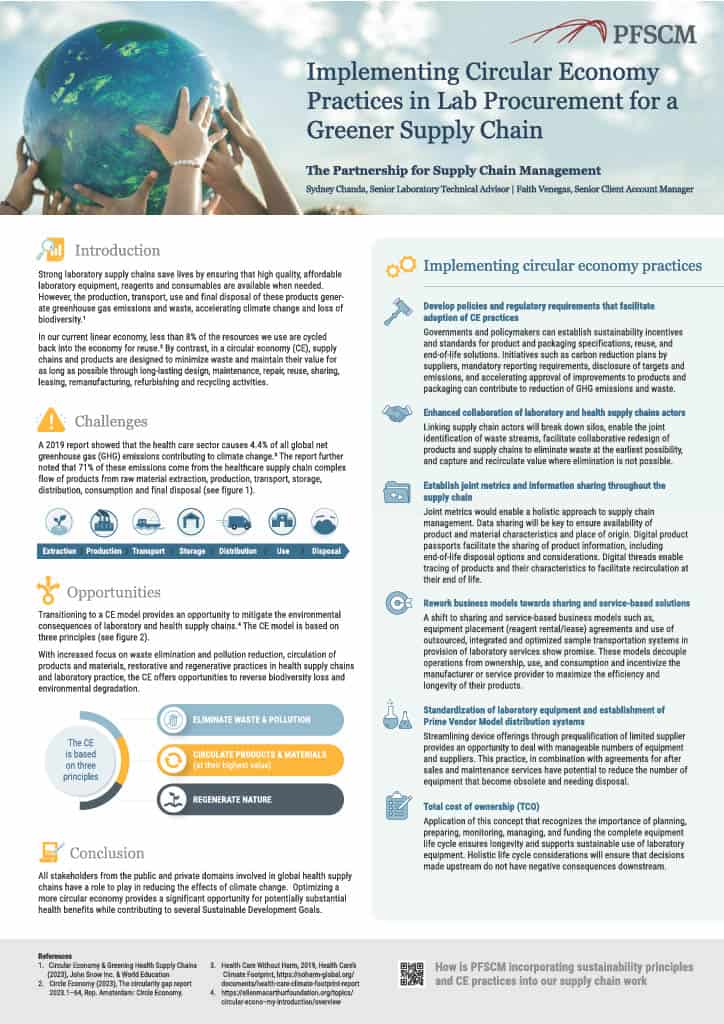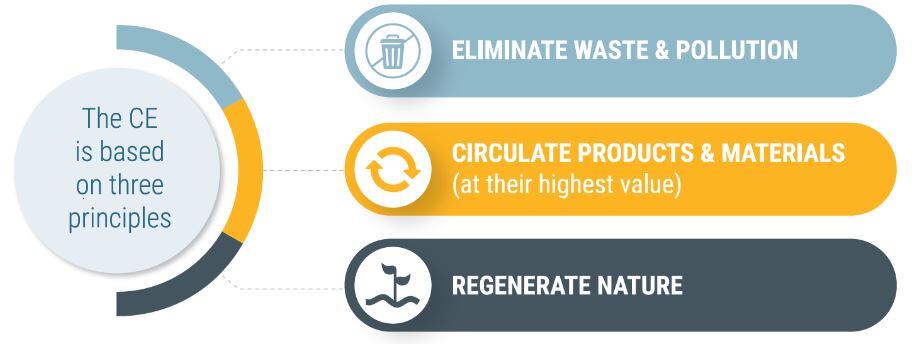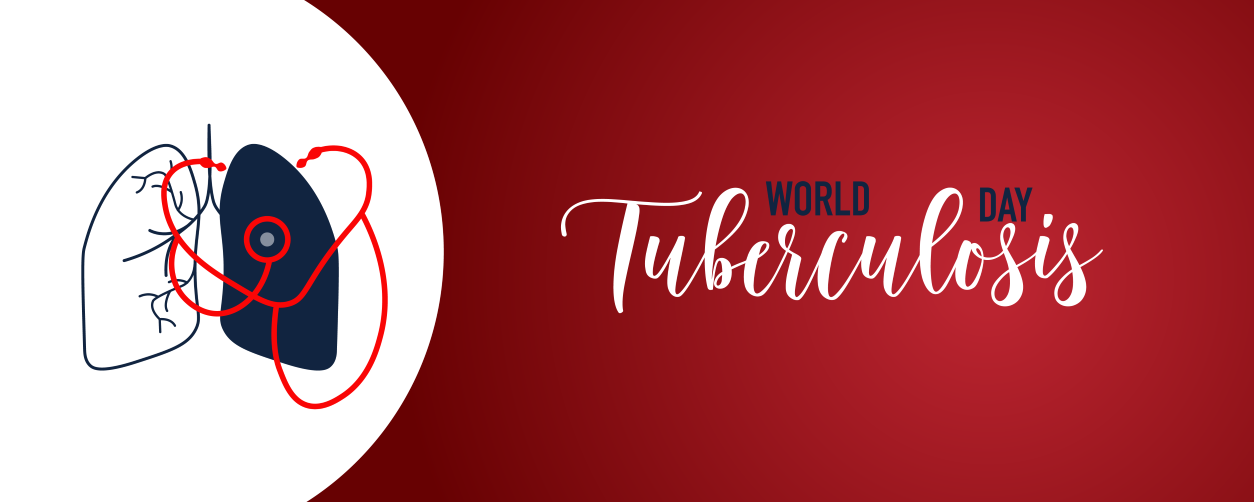Strong laboratory supply chains save lives by ensuring that high-quality, affordable laboratory equipment, reagents, and consumables are available when needed.
However, the production, transport, use, and final disposal of these products generate greenhouse gas emissions and waste, accelerating climate change and loss of biodiversity.1
In the current linear economy, less than 8% of our resources are cycled back into the economy for reuse.2
By contrast, in a circular economy (CE), supply chains and products are designed to minimize waste and maintain their value for as long as possible through long-lasting design, maintenance, repair, reuse, sharing, leasing, remanufacturing, refurbishing, and recycling activities.
Challenges
A 2019 report showed that the healthcare sector contributes 4.4% of all global net greenhouse gas (GHG) emissions to climate change.3
The report further noted that 71% of these emissions come from the complex flow of products in the healthcare supply chain, including raw material extraction, production, transport, storage, distribution, consumption, and final disposal (see Figure 1).
Figure 1
Opportunities
Transitioning to a CE model provides an opportunity to mitigate the environmental consequences of laboratory and health supply chains.4
The CE model has three principles (see Figure 2).
With increased focus on waste elimination and pollution reduction, circulation of products and materials, restorative and regenerative practices in health supply chains, and laboratory practice, the CE offers opportunities to reverse biodiversity loss and environmental degradation.
Figure 2:
Implementing circular economy practices
Develop policies and regulatory requirements that facilitate the adoption of CE practices:
- Governments and policymakers can establish sustainability incentives and standards for product and packaging specifications, reuse, and end-of-life solutions.
- Initiatives such as suppliers’ development and adherence to carbon reduction plans, setting mandatory reporting requirements, disclosure of targets and emissions, and accelerating approval of improvements to products and packaging can contribute to reducing GHG emissions and waste.
Establish joint metrics and information sharing throughout the supply chain:
- Joint metrics would enable a holistic approach to supply chain management.
- Total cost of ownership (TCO) and life cycle considerations can be taken as a whole so that decisions made upstream do not have negative consequences downstream.
- Data sharing will be key to ensuring the availability of product and material characteristics and place of origin.
- Digital product passports facilitate the sharing of product information, including end-of-life disposal options and considerations. Digital threads enable the tracing of products and their characteristics to facilitate recirculation at their end of life.
Enhanced collaboration of laboratory and health supply chain actors:
 Linking actors throughout supply chains will break down silos, enable the joint identification of waste streams, facilitate the collaborative redesign of products and supply chains to eliminate waste at the earliest possibility, and capture and recirculate value where elimination is not possible.
Linking actors throughout supply chains will break down silos, enable the joint identification of waste streams, facilitate the collaborative redesign of products and supply chains to eliminate waste at the earliest possibility, and capture and recirculate value where elimination is not possible.
- PFSCM uses a load optimization tool to flag large-volume shipments. This enables collaboration with manufacturers, transporters, and end recipients of medical products to reduce excess packaging and make the most efficient use of cargo space. Such practices and tools can be scaled to incorporate each stage of the supply chain, resulting in greater efficiencies.
Rework business models towards sharing and service-based solutions:
- PFSCM supports sharing and service-based business models, incentivizing manufacturers and service providers to maximize the efficiency and longevity of their products.
- A shift to sharing and service-based business models, such as equipment placement (reagent rental/lease) agreements and the use of outsourced, integrated, and optimized sample transportation systems in the provision of laboratory services, has shown promise and could be expanded. These models decouple operations from ownership, use, and consumption and incentivize the manufacturer or service provider to maximize the efficiency and longevity of their products. PFSCM has experience and can help suppliers and procurers set up and manage these types of agreements.
Standardization of laboratory equipment and establishment of Prime Vendor Model distribution systems:
- Defining and streamlining device offerings through prequalification of limited manufacturers/distributors provides an opportunity to deal with manageable numbers of equipment and manufacturers/distributors.
This practice, in combination with agreements for ongoing after-sales and maintenance or rental/lease services, has the potential to reduce the number of equipment that become obsolete and need disposal. PFSCM has been involved in encouraging the adoption of these practices, having conducted assessments in Zambia and Uganda on the feasibility of Prime Vendor Model distribution for maternal, newborn, & child health (MNCH) equipment. During these assessments, PFSCM found several different brands and models of the same type of equipment in health facilities as well as across the country. This led to staff often not knowing how to use the equipment, and Biomedical Engineers being unable to fix certain equipment (due to a lack of training and the appropriate tools being unavailable). An even bigger issue was that consumables could not be procured locally for some products, rendering the equipment unusable.
Before the assessment, PFSCM did a local supplier landscape in Uganda and Zambia for MNCH equipment and services, and both countries had local suppliers who could successfully offer a Prime Vendor Model procurement service to the respective Ministries of Health. It might not be an appropriate procurement method for some products, but a lot can be gained from diversifying how different product categories are procured.
Total cost of ownership
- The application of the TCO concept is one of PFSCM’s approaches to laboratory and medical equipment. The approach aims to estimate the cost of procuring, using and retiring a piece of equipment across the product’s lifecycle.
- Application of this concept recognizes the importance of planning, preparing, monitoring, managing, and funding the complete equipment life cycle ensures longevity and supports sustainable use of laboratory equipment.
- By recognizing the importance of the complete equipment life cycle and its impact on sustainability, the TCO concept reduces waste and ensures sustainable use of laboratory equipment and medical devices.
Even with basic devices, performing a simple TCO exercise is beneficial. An example is glucometers. During an assessment performed by PFSCM, 15% to 25% of glucometers in two countries were not in use even though they were in good working condition. The reason was that the corresponding brand strips were unavailable on the local market and there was no budget for international procurements. A simple TCO exercise would have taken the landed cost of the glucometers and consumables over a five to six year period (estimated shelf life) into consideration as well as other benefits such as local availability. PFSCM encourages countries to apply this concept. In July 2022, PFSCM incorporated a discussion on key concepts in performing a TCO analysis into an Assessment for Selected Medical Devices with key stakeholders in Uganda and Zambia.
Conclusion
All stakeholders from the public and private domains involved in global health supply chains have a role to play in reducing the effects of climate change. Optimizing a more circular economy provides a significant opportunity for potentially substantial health benefits while contributing to several Sustainable Development Goals.
References:
1Circular Economy & Greening Health Supply Chains (2023), John Snow Inc. & World Education.
2Circle Economy (2023), The circularity gap report 2023.1-64, Rep. Amsterdam: Circle Economy.
3Health Care Without Harm, 2019, Health Care’s Climate Footprint.
This blog was compiled by Sydney Chanda & Faith VENEGAS













